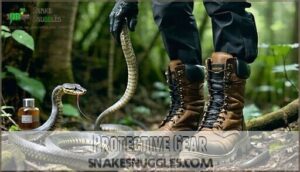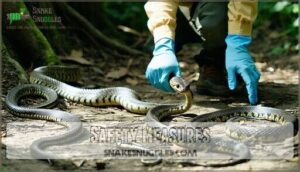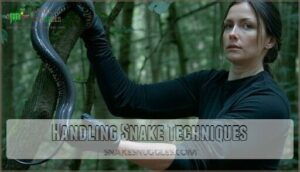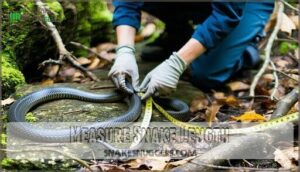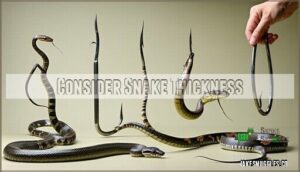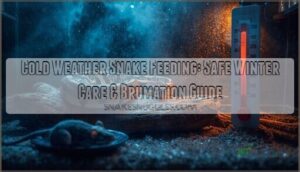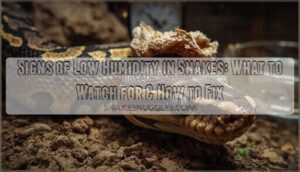This site is supported by our readers. We may earn a commission, at no cost to you, if you purchase through links.
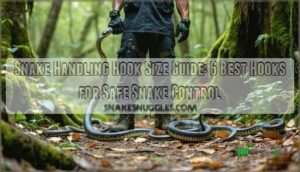
For snakes under 3 feet, grab a 24-36 inch hook. Medium snakes (3-6 feet) need 36-48 inch tools, while large constrictors demand the full 48-60 inch reach.
Don’t forget width matters too—wider hooks handle heavy-bodied snakes better, while narrow ones give you precision with delicate species. Remember, there’s no such thing as "too long" in regard to keeping dangerous distance.
The pros who’ve been doing this for years have some clever tricks for matching hook specs to snake behavior patterns.
Table Of Contents
- Key Takeaways
- Choosing Snake Hooks
- Snake Handling Safety
- Top 6 Snake Hooks
- Handling Snake Techniques
- Selecting Hook Size
- Frequently Asked Questions (FAQs)
- Are snake hooks and tongs safe?
- What are snake hooks used for?
- How do you handle a snake with a hook?
- How big should a snake hook be?
- What safety equipment do you need for snake handling?
- What tools do snake handlers need?
- What size snake hook do I need?
- What length snake tongs do I need?
- What hook materials resist corrosion best?
- How often should hooks be replaced?
- Conclusion
Key Takeaways
- Match hook length to snake size using the 1.5-2x rule – You’ll need 24-36 inches for snakes under 3 feet, 36-48 inches for medium snakes (3-6 feet), and 48-60 inches for large constrictors to maintain a safe distance.
- Consider both length and width for proper control – You’ll want wider hooks for heavy-bodied snakes like vipers to distribute weight across the ribs, while narrow hooks give you precision with delicate species.
- Factor in species temperament and behavior – You’ll need longer hooks for aggressive or venomous species like mambas and shorter tools for docile snakes like ball pythons, as temperament affects the required safety distance.
- Use proper technique with slow, deliberate movements – You’ll prevent defensive strikes by moving slowly, rather than darting, and supporting the snake at one-third of its body length for balanced control.
Choosing Snake Hooks
Selecting the right snake hook depends on matching your tool to the specific snake species and individual size you’re handling.
You’ll need to evaluate both the snake’s length and body thickness to guarantee safe, effective control while maintaining proper distance from potentially dangerous bites.
Consider Snake Species
Different snake species require specialized handling approaches based on their temperament and behavior patterns.
Venomous snakes like eastern brown snakes demand longer hooks for safety, while docile ball pythons tolerate shorter tools.
Species types vary dramatically—aggressive black mambas need maximum distance, but king snakes often handle easily.
Understanding snake behavior and temperament helps you select appropriate snake hook length for each encounter.
When dealing with various species, to guarantee safe handling, study snake identification methods is necessary to make informed decisions about snake hook length.
Handle Snake Size
Measuring your snake accurately determines the right hook size for safe handling. Snake length directly impacts handle size requirements, while species guide recommendations guarantee you’re using appropriate snake handling techniques for different temperaments.
When handling snakes, it’s vital to follow proper snake handling guidelines to minimize risks.
Essential snake hook size considerations:
- 24-36" hooks – Perfect for small to medium snakes under 3 feet, giving you control without being cumbersome
- 40-52" hooks – Necessary for larger species, providing crucial distance from powerful strikes and heavy bodies
- Mini-hooks under 24" – Designed for delicate hatchlings where precision matters more than reach
- Hook material strength – Heavier snakes need stronger aluminum or steel construction to prevent dangerous bending
- Safety tips mandate – Follow snake handling guidelines: use the one-third rule for balanced lifting
Snake Handling Safety
When you’re working with snakes, proper safety gear isn’t just recommended—it’s your lifeline between a successful handling session and a trip to the emergency room.
You’ll need puncture-resistant gloves, sturdy boots, and protective clothing to create multiple barriers between you and those lightning-fast fangs.
Protective Gear
While proper snake handling hook size guide selection remains vital, your protective gear serves as your last line of defense against unpredictable strikes.
You’ll need puncture-resistant gloves, safety boots covering your ankles, and eye protection. Don’t forget first aid supplies and hand sanitizer for post-handling cleanup.
Understanding snake handling safety is essential for preventing accidents and ensuring a secure environment.
| Essential Gear | Purpose | Key Feature |
|---|---|---|
| Puncture Gloves | Hand protection | Animal-rated materials |
| Safety Boots | Ankle coverage | Thick leather construction |
| Eye Protection | Strike defense | Impact-resistant lenses |
Safety Measures
Beyond protective gear, you’ll need emergency kits with First Aid supplies and antiseptic for immediate wound care.
Conduct thorough Risk Assessment before each encounter—recently fed or shedding snakes are unpredictable.
Keep emergency contacts handy and inspect your snake handling hook size guide regularly.
Safe Handling means understanding snake behavior patterns and maintaining proper distance.
Your puncture-resistant gloves won’t help if you’re overconfident, emphasizing the need for proper distance.
Top 6 Snake Hooks
You’ll need the right snake hook to handle different species safely and effectively.
These six top-rated hooks offer various lengths and features to match your specific snake handling needs, from lightweight options for smaller species to heavy-duty tools for larger, more aggressive snakes.
1. Coghlan’s Snake Bite Kit Six Pack
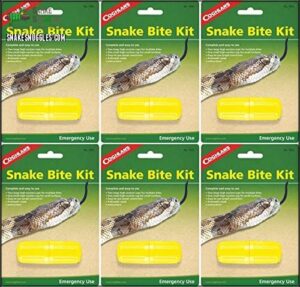
I need to clarify something important about this product.
The Coghlan’s Snake Bite Kit Six Pack isn’t actually a snake hook – it’s a bite treatment kit that medical experts strongly advise against using.
This kit contains suction cups and a scalpel, but suction devices can cause more harm than good by damaging tissue without removing venom.
You’d be better off skipping this outdated approach entirely.
Instead, focus on proper snake hooks for safe handling and seek immediate medical attention for any bite.
Don’t let marketing fool you into thinking suction kits work.
Best For: Outdoor enthusiasts or campers seeking a lightweight, basic first-aid kit for remote snake bite emergencies, despite modern medical advice.
- Compact and lightweight to carry on hikes or camping trips
- Includes multiple suction cups, a lymph constrictor, antiseptic, and a scalpel
- Comes with clear instructions for emergency use in the field
- Suction devices are not medically recommended and can worsen injury
- Not proven to remove venom effectively or improve outcomes
- Can provide a false sense of security, potentially delaying proper medical care
2. Pro Super Heavy Duty Snake Tong

When you’re dealing with aggressive or large snakes, nothing beats the confidence of professional-grade tongs.
The Pro Super Heavy Duty Snake Tong features 19mm aluminum alloy tubing that won’t bend under pressure, even when a six-foot rattlesnake decides to throw a tantrum.
Its 47-inch length keeps you safely distanced while wide, rubber-coated jaws provide a secure grip without crushing ribs.
The pistol-grip handle reduces fatigue during extended use, and some models include auto-lock features to prevent accidental releases, ensuring a safe handling experience.
Best For: Homeowners, ranchers, and field workers who need a safe, reliable tool for handling large or venomous snakes in outdoor or residential settings.
- Extra-durable 19mm alloy tubing and wide, rubber-coated jaws ensure lasting strength and a humane grip.
- 47-inch length keeps hands at a safe distance from aggressive or venomous snakes.
- Pistol-grip handle and auto-lock features make extended use comfortable and safe.
- Length may feel excessive when handling smaller snakes or in tight spaces.
- Takes practice to position tongs efficiently under cautious or small reptiles.
- Storage can be tricky due to overall size.
3. stainless steel alligator forceps tool
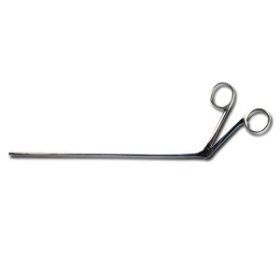
Why settle for basic tools when precision matters most? These 14-inch stainless steel alligator forceps deliver surgical-grade control for delicate snake handling operations.
With serrated 3/4-inch jaws and an angled handle, you’ll maintain safe distance while securely gripping smaller specimens or feeding prey items.
The autoclavable construction means you can sterilize between uses—essential for preventing cross-contamination.
Perfect for veterinary work or handling defensive species that require finesse over brute force.
Best For: Veterinarians, reptile keepers, and technicians needing safe, precise handling or feeding of small animals and snakes in tight spaces.
- Limited jaw opening restricts use to thinner objects or prey.
- Not suitable for heavy-duty or industrial applications; may break under excessive force.
- Requires prompt cleaning after saltwater contact to prevent corrosion.
- Autoclavable stainless steel resists corrosion and supports medical-grade sterilization.
- Long, angled shaft and serrated jaws allow secure grip while keeping hands at a safe distance.
- Effective for retrieving, feeding, or handling in delicate or hard-to-reach areas.
4. Complete Guide to Snake Encyclopedia

While you might think a snake encyclopedia doesn’t belong in a hook guide, Chris Mattison’s exhaustive reference proves invaluable for safe handling.
You’ll find detailed species descriptions, behavior patterns, and identification features across 200 color photographs.
Understanding whether you’re dealing with a defensive ball python or aggressive elapid directly impacts your hook selection and technique.
The book’s accessible language makes complex snake behavior understandable, helping you recognize stress signals and temperament variations.
It’s like having an expert herpetologist guiding your decisions before you pick up that hook.
Best For: Anyone seeking a comprehensive, visually engaging reference on snakes—especially enthusiasts, students, herpetologists, and curious learners of all ages.
- Richly illustrated with 200 color photos and clear species descriptions.
- Accessible language and thematic organization, suitable for multiple age groups.
- Helps identify snake behavior and makes complex topics understandable for safer handling.
- Not a care or handling manual; lacks in-depth molecular biology.
- Some overlap with documentary content familiar to enthusiasts.
- Does not offer step-by-step guidance for keeping snakes as pets.
5. Snake Catching And Control Hook
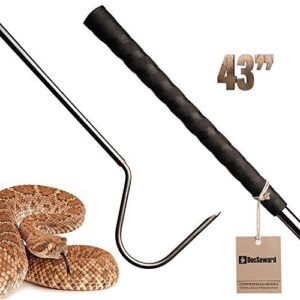
Professional snake catching hooks deliver the precision you need for safe reptile control.
These specialized tools feature aluminum or stainless steel shafts ranging from 31.5 to 46.5 inches, with 40-inch lengths offering ideal balance between reach and maneuverability.
You’ll find foam grips that reduce fatigue during extended handling sessions, while flat or L-shaped hook designs distribute weight evenly across snake ribs.
Heavy-duty models support large constrictors exceeding 20 pounds, preventing injury through proper weight distribution and secure lifting capability, which ensures safe handling of the snakes.
Best For: Reptile enthusiasts, biologists, and professionals needing safe, reliable tools for handling and relocating snakes of all sizes.
- Higher upfront cost compared to basic or makeshift alternatives.
- Bulkier heavy-duty models may be less convenient for quick or compact transport.
- May require regular inspection for wear to ensure ongoing safety and effectiveness.
- Durable stainless steel or aluminum construction provides long-term reliability and safe handling.
- Ergonomic foam grips and balanced design reduce fatigue and enhance control during use.
- Wide range of lengths and hook styles accommodate both small and large snakes for versatile applications.
6. Long Handle Snake Removal Hook
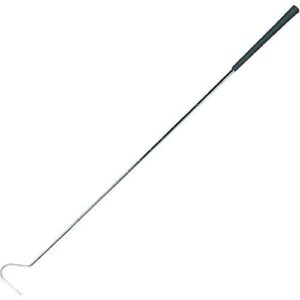
When snakes get out of reach, long handle removal hooks stretch your safety zone to 44-48 inches.
These stainless steel workhorses keep you well beyond striking distance while giving you the control you need. Perfect for those "snake under the deck" situations where you can’t get close.
The sturdy construction handles heavy-bodied serpents without breaking a sweat, and the non-slip grip won’t let you down when things get dicey.
Think of it as your snake-handling insurance policy. Understanding proper snake handling techniques is essential for a safe and successful removal process.
Best For: Outdoor enthusiasts, herpetologists, or anyone needing a safe, easy way to relocate or handle snakes from a distance.
- Shaft can dent if struck too hard or used aggressively.
- Design might be obvious as a modified golf club, which some may not prefer.
- Not suitable for very heavy impacts or aggressive snake behavior.
- Keeps you safely out of striking range with a sturdy, long reach.
- Solid construction handles even large, heavy-bodied snakes.
- Non-slip grip ensures secure handling in tough conditions.
Handling Snake Techniques
Once you’ve got your hook in hand, mastering proper technique becomes your lifeline between safe handling and a trip to the emergency room.
Your movements should flow like honey, not dart like a hummingbird, because sudden jerks trigger defensive strikes faster than you can say "oops.
Slow Deliberate Movements
When mastering Movement Control during Snake Handling, remember that haste makes waste—and potentially dangerous bites.
Your Calm Approach should mirror a yoga instructor’s flow, using deliberate motions that telegraph your intentions.
Maintain Safe Distance with your snake handling hook size guide-recommended tool, employing Gentle Touch techniques.
Quick jerky movements trigger defensive responses, while steady snake handling techniques with proper hook length and snake hook material create trust, ensuring successful gentle handling every interaction.
Understanding snake handling techniques is essential for a safe and enjoyable experience with snakes.
Recognize Stress Signals
Watch your snake’s body language carefully—it’s talking to you without words.
Hissing, tight coiling, striking at air, and rigid posture all scream "back off!"
A stressed snake might also hide constantly or dart around frantically.
Recently fed or shedding snakes become extra cranky, so give them space.
Reading these stress signals keeps both you and your scaly friend safe during handling sessions.
Selecting Hook Size
Choosing the right hook size isn’t rocket science, but getting it wrong can turn a routine snake encounter into a dangerous wrestling match.
You’ll want to match your hook length to both the snake’s size and your comfort level—longer isn’t always better if you can’t control it properly.
Measure Snake Length
Accurate snake length measurement directly impacts your hook size selection and safety.
Use flexible measuring tape along the snake’s spine, not straight-line distance, for precise results. The string method works well—trace the spine, then measure against a ruler.
Photographic methods with scale references help with uncooperative snakes. Always measure multiple times for consistency.
For the best results, consider using a high-quality measure tape tool to guarantee accurate measurements and ensure safety.
Consider Snake Thickness
Everyone knows that snake thickness dramatically impacts your hook materials and handling techniques.
Thicker snakes require specialized equipment that distributes weight properly across their ribs and vertebrae.
Key thickness considerations for snake hook size:
- Delicate neonates – Use polycarbonate hooks to prevent rib crushing
- Medium snakes – Choose 3/8-inch diameter hooks for proper support
- Heavy-bodied vipers – Select broader hooks to prevent V-shaped folding damage
- Large constrictors – Employ dual hooks with substantial width for safe control
- Gaboon vipers – Use hooks covering multiple ribs spaced ¼-inch apart.
Match your snake hook size to the animal’s girth for vital safety precautions and effective snake behavior management.
Understanding proper snake hook designs is essential for handling various species.
Frequently Asked Questions (FAQs)
Are snake hooks and tongs safe?
Snake hooks and tongs are safe when properly used with correct technique, quality equipment, and appropriate protective gear.
They’re essential tools that maintain vital distance between you and potentially dangerous snakes during handling situations.
What are snake hooks used for?
You’ll use snake hooks to safely lift, move, and control snakes while maintaining distance from their fangs.
They’re essential for relocating both venomous and non-venomous species without direct hand contact, preventing bites.
How do you handle a snake with a hook?
Hold your hook about one-third down the snake’s body for balance.
Keep steady pressure while supporting the snake’s weight.
Move slowly and let the snake settle naturally around the hook—rushing leads to defensive strikes.
How big should a snake hook be?
Like choosing the right fishing rod for your catch, you’ll need a 24-36 inch hook for medium snakes, 12-16 inches for babies, and 36-48 inches for larger species.
Match your tool’s length to your snake’s size for safe, controlled handling.
What safety equipment do you need for snake handling?
You’ll need puncture-resistant gloves, sturdy ankle-high boots, long sleeves, and eye protection. Add a snake hook, secure transport container, and first aid kit for complete safety coverage.
What tools do snake handlers need?
Essential handlers require hooks, tongs, protective gear, and containers.
You’ll need tongs for gripping, puncture-resistant gloves, sturdy boots, thick clothing, and secure transport containers for safe snake management.
Essential equipment includes hooks for lifting.
What size snake hook do I need?
Choose your hook length based on snake size: 12-16 inches for baby snakes, 24-36 inches for medium species, and 36-48 inches for larger ones.
You’ll want enough distance for safety without losing control.
What length snake tongs do I need?
For snake tongs, you’ll want 24-36 inches for most medium snakes, while larger species need 36-48 inch tools.
Match your tong length to the snake’s size for safe handling distance and control.
What hook materials resist corrosion best?
While you might think all metals work equally well, stainless steel and copper stand out for snake hooks.
Stainless steel offers superior corrosion resistance and durability, while copper provides antimicrobial properties and lightweight handling for extended use.
How often should hooks be replaced?
You’ll want to replace hooks annually or sooner if you spot rust, bent angles, or loose joints.
Regular inspections after each use help catch wear early—your safety‘s worth more than saving a few bucks on replacement gear.
Conclusion
Mastering your snake handling hook size guide is like learning to play the piano—every note must be perfect for a safe performance.
You’ve now got the knowledge to match hook length to snake size, understand species-specific needs, and recognize quality tools.
Remember that 1.5-2x rule for length selection, and don’t skimp on width for heavy-bodied species.
Your safety depends on choosing the right tool for each situation.
Practice these techniques, respect every snake’s potential danger, and you’ll handle serpents with confidence and precision.

